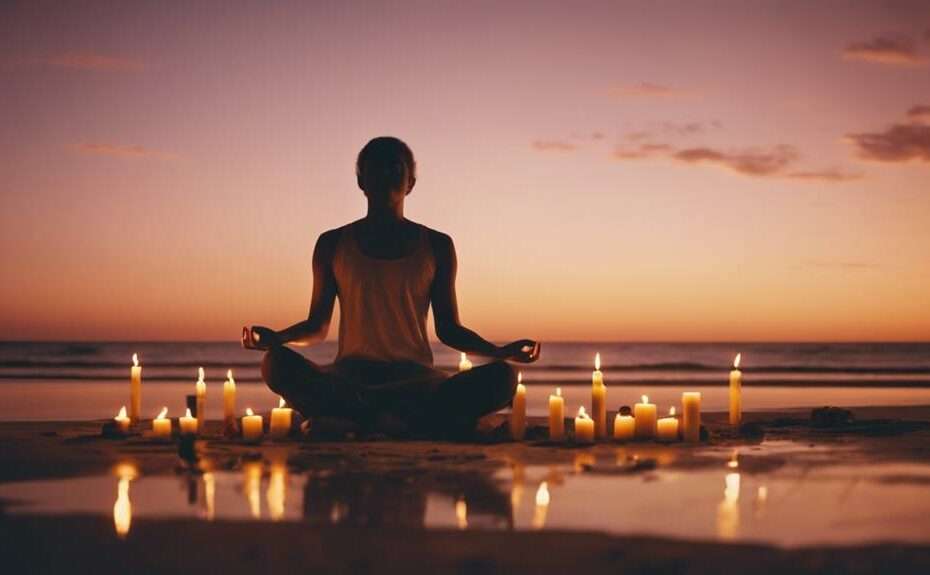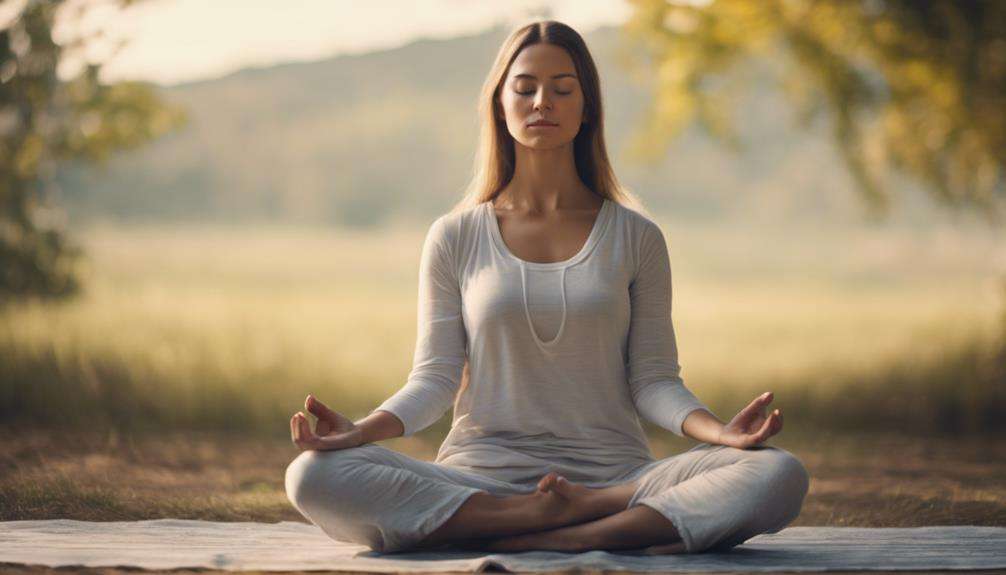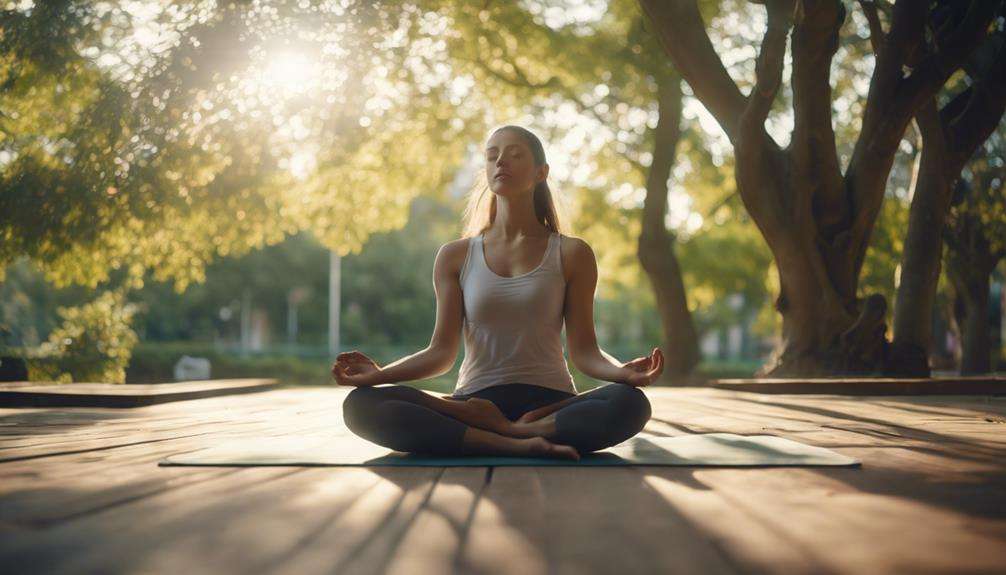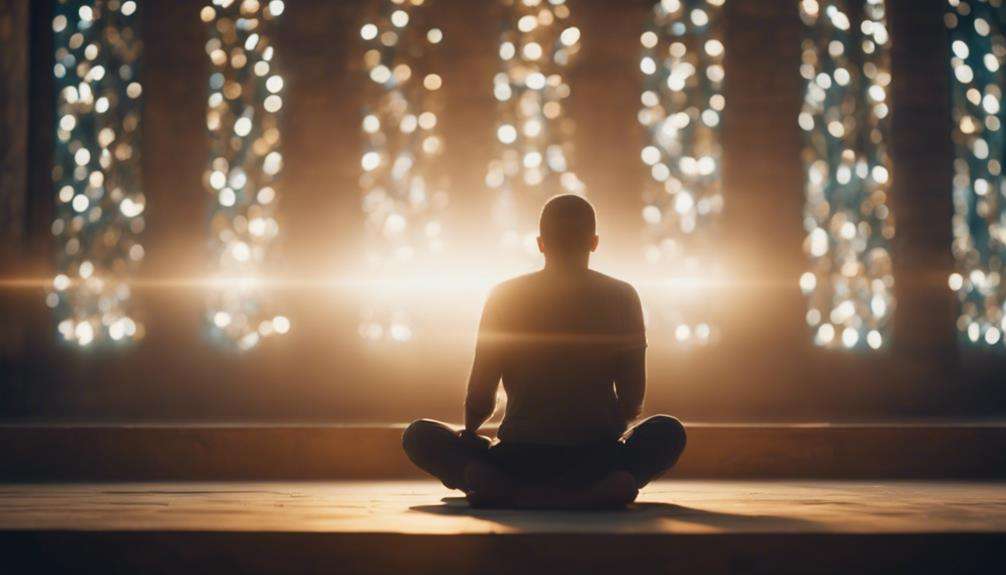When it comes to achieving a state of calm amidst life's chaos, envision yourself mastering the art of mental balance through the practice of 7 meditation techniques.
By exploring each method, from mindfulness meditation to rhythmic exercise, you can uncover a pathway to tranquility and emotional well-being.
These strategies offer a gateway to not just relaxation but also enhanced self-awareness and stress management.
Begin your journey towards inner peace and serenity by embracing these diverse meditation approaches – each holding the possibility of transforming your daily experience.
Key Takeaways
- Mindfulness and loving-kindness meditations enhance self-awareness, reduce negative emotions, and foster emotional resilience.
- Body-centered techniques like body scan and progressive muscle relaxation release tension, promote relaxation, and enhance mental balance.
- Breath-centered meditation improves self-awareness, emotional balance, and concentration through regulating breath rhythm.
- Visualization and movement-based meditations promote relaxation, reduce stress, and enhance mental well-being through sensory engagement and intentional movements.
Mindfulness Meditation
Mindfully focusing on the present moment without judgment can significantly enhance your self-awareness and reduce negative emotions. Meditation is a powerful tool for improving your mental health and overall well-being. When you engage in mindfulness meditation, you train your mind to stay focused on the present, allowing you to let go of stress and worries about the past or future. By bringing your attention to your body and thoughts without attaching judgment, you create a sense of relaxation and calm within yourself.
This practice not only benefits your mental health but also has a positive impact on your physical health. Studies have shown that mindfulness meditation can lower blood pressure, improve immune function, and increase mental clarity. By learning to direct your attention and observe your thoughts without getting caught up in them, you develop a deeper understanding of your mind-body connection. Embracing mindfulness meditation can help you navigate through life's challenges with a greater sense of ease and resilience.
Loving-kindness Meditation
To cultivate feelings of goodwill and compassion towards oneself and others, loving-kindness meditation involves sending positive intentions and wishes for happiness, health, and peace to all beings. This practice is a powerful tool for developing compassion, empathy, and emotional resilience.
Here are some key benefits of loving-kindness meditation:
- Reduces Self-Criticism: By fostering self-compassion and kindness, this meditation technique can help you become less harsh towards yourself.
- Increases Empathy: Regular practice of loving-kindness meditation enhances your ability to understand and share the feelings of others, promoting a deeper sense of connection.
- Enhances Emotional Resilience: Research suggests that engaging in loving-kindness meditation can strengthen your emotional resilience, helping you cope better with stress and challenges.
Through the practice of loving-kindness meditation, you can cultivate a positive outlook, reduce symptoms of depression and anxiety, and foster emotional balance by acknowledging the interconnectedness of all beings.
Body Scan Meditation

When practicing body scan meditation, focus on the sensations in each body part without judgment. Allow yourself to relax and release any tension you may be holding.
Focus on Sensations
Embark on a journey of self-awareness and relaxation by delving into the practice of body scan meditation, focusing your attention on the sensations within each part of your body. Body scan meditation allows you to cultivate mindfulness and enhance your body awareness. By tuning into these sensations without judgment, you can identify areas of tension and release, promoting relaxation and stress relief.
Here are three benefits of focusing on sensations during body scan meditation:
- Heightened awareness of bodily responses
- Recognition and release of tension
- Enhanced relaxation and mental balance
Engage in this practice to nourish your mind and body, fostering a deeper connection to yourself and promoting overall well-being.
Relax and Release
Begin your journey to relaxation and self-awareness with the practice of body scan meditation. This technique focuses on releasing tension and promoting mindfulness through heightened body awareness. Body scan meditation involves systematically bringing attention to each part of your body. By practicing this meditation, you can identify areas of tension and release them, aiding in stress relief and emotional balance.
Start from your feet and slowly move your awareness up through your body. Notice any sensations you may be experiencing without judgment. Incorporating sensory details and visualizing each body part can enhance this calming practice, providing a grounding experience for your mental well-being.
Consider using guided audio for a more immersive body scan meditation session.
Breath Awareness Meditation
When starting breath awareness meditation, focus on your breath as it naturally flows in and out. This technique fosters a strong mind-body connection, helping you achieve a state of calmness and clarity.
Embracing this practice can guide you towards a more relaxed and centered state of being.
Focus on Breath
To begin cultivating mindfulness and mental balance through breath awareness meditation, focus on the natural rhythm of your breath. By engaging in this practice, you can enhance self-awareness, reduce stress, and promote inner peace.
Here are three tips to help you enjoy the benefits of breath awareness meditation:
- Find a comfortable position to sit or lie down.
- Close your eyes and bring your attention to the sensation of your breath entering and leaving your body.
- Whenever your mind starts to wander, gently guide your focus back to the rhythmic flow of your breath.
Incorporating breath awareness into your daily routine can support emotional balance and overall well-being. Start today to experience the calming effects of this simple yet powerful technique.
Mind-Body Connection
As you deepen your breath awareness meditation practice, you'll discover the profound connection between your mind and body, fostering a harmonious balance within yourself.
Breath awareness meditation cultivates mindfulness and mental clarity, enhancing self-awareness through focusing on the sensations of inhalation and exhalation. By anchoring your attention on the breath, you can stay present, reducing racing thoughts and distractions.
This practice aids in regulating emotions, lowering stress levels, and fostering calmness and inner balance. Regular practice of breath awareness meditation improves concentration, promotes relaxation, and nurtures a deeper mind-body connection.
Embrace this technique to experience the benefits of improved mental well-being and overall harmony within yourself.
Calmness and Clarity
Embrace the practice of Breath Awareness Meditation to cultivate a profound sense of calmness and clarity within yourself. This mindfulness practice encourages you to observe the natural flow of your breath, anchoring your attention and allowing you to enhance mental focus. As you engage in Breath Awareness Meditation, you can promote relaxation, reduce stress levels, and increase self-awareness. By regularly practicing this technique, you'll find yourself experiencing improved emotional balance and a greater sense of inner peace. Let your breath be your guide to a tranquil state of mind and a harmonious equilibrium within.
Enjoy these benefits of Breath Awareness Meditation:
- Cultivate calmness
- Enhance mental focus
- Promote relaxation
Progressive Muscle Relaxation
Engage in Progressive Muscle Relaxation to systematically release tension and promote deep relaxation throughout your body. This technique focuses on recognizing and releasing muscle tension by tensing and relaxing different muscle groups gradually.
Starting from your feet, move upwards through your body, tensing each muscle group before slowly releasing the tension. Combine this practice with deep breathing to enhance stress relief and achieve overall relaxation.
By wearing comfortable clothing and paying attention to the gradual release of tension in each muscle group, you can effectively use this systematic technique to attain physical and mental relaxation.
Progressive Muscle Relaxation helps you unwind and unwind, allowing you to let go of the stress and tension that may have built up throughout your day. Practice this method regularly to experience the soothing benefits of deep relaxation and muscle tension relief.
Visualization Meditation
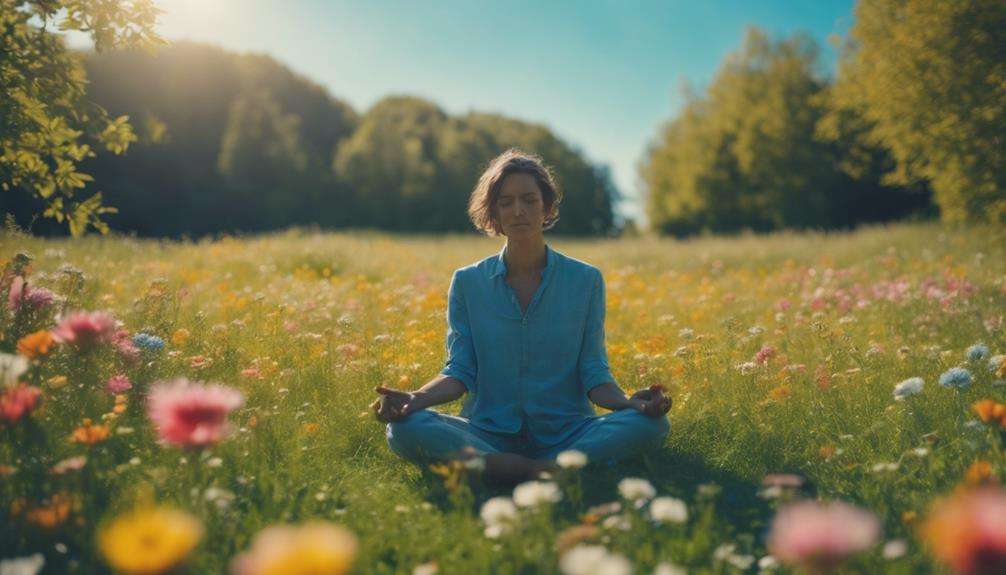
To shift gears from Progressive Muscle Relaxation, consider exploring Visualization Meditation as a practice for promoting relaxation and reducing stress by creating mental images of peaceful scenes or scenarios. Visualization meditation is a mindfulness practice that can significantly benefit your mental health. By engaging your senses and imagination, this technique can help evoke feelings of calmness and tranquility, leading to a reduction in stress levels.
Research indicates that regular practice of visualization meditation can improve your mood, reduce anxiety, and enhance your overall well-being. Additionally, this practice can also help enhance your focus, creativity, and emotional balance. Here are three ways visualization meditation can positively impact your life:
- Enhances mood and emotional balance
- Reduces stress and anxiety
- Improves focus and creativity
Incorporating visualization meditation into your daily routine can be a powerful tool for promoting mental balance and relaxation.
Movement-Based Meditation
Movement-Based Meditation involves incorporating mindful practices such as yoga, qigong, tai chi, and walking to promote relaxation and enhance mental well-being through intentional physical movements and coordinated breathing. These practices not only strengthen the body but also focus on mental health by combining movement with mindfulness meditation.
By engaging in tai chi, qigong, yoga, or walking meditation, you can experience a deeper sense of relaxation and emotional balance. Coordinating your breath with each movement helps center your mind, reducing stress and promoting a sense of calm. Grounding techniques, such as feeling the earth beneath your feet during these practices, facilitate a stronger mind-body connection.
Embracing mindful movement not only increases body awareness but also aids in stress reduction, providing a holistic approach to improving both physical and mental health. Incorporating these movement-based meditations into your routine can support your overall well-being and help you achieve a state of mental and emotional equilibrium.
Frequently Asked Questions
How to Do Meditation to Relax Mind?
To relax your mind, try deep breathing. Focus on your breath, in and out, slowly. This simple practice can calm your thoughts and bring a sense of peace. Give it a try whenever you feel stressed.
How Do You Meditate for Mental Clarity?
To meditate for mental clarity, focus on the present moment without judgment. Practice mindfulness, deep breathing, and visualization techniques. Engage in body scans, mantra meditation, walking meditation, and loving-kindness. Try progressive relaxation, guided imagery, or sound therapy for balance.
How Do I Relax My Body While Meditating?
When meditating, relax your body by practicing deep breathing, engaging in progressive relaxation, and focusing on a body scan. These techniques help release tension, calm your mind, and promote a state of deep relaxation.
How Do You Meditate Balance?
When meditating for balance, you can practice mindful breathing, body scan, grounding techniques, visualization, progressive relaxation, loving kindness, mantra meditation, yoga poses, nature immersion, and sound therapy. Combine these methods for a personalized routine.
Conclusion
Incorporating meditation into your daily routine can significantly improve your mental well-being.
Did you know that studies have shown that just 10 minutes of daily meditation can reduce anxiety levels by up to 40%?
By practicing mindfulness, loving-kindness, and other meditation techniques, you can experience relaxation, inner peace, and better stress management.
Remember, taking care of your mental health is just as important as taking care of your physical health. Keep meditating and reap the benefits!
